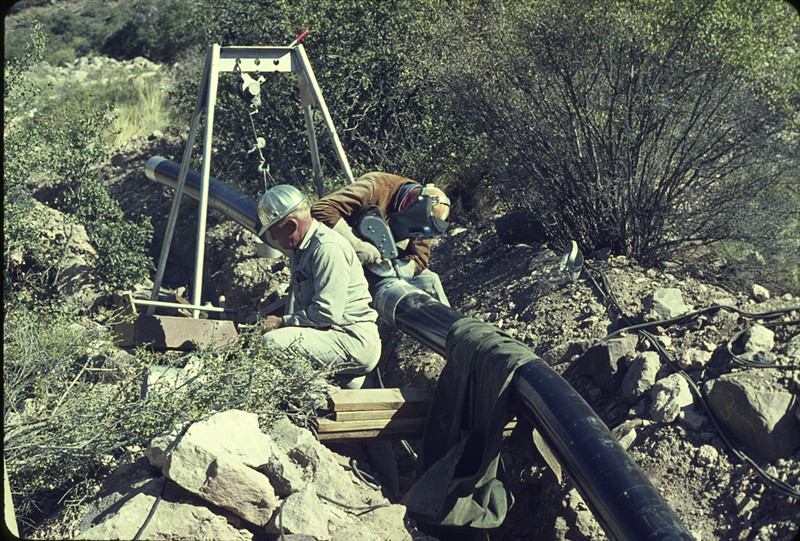Some of Roger Clark’s earliest childhood memories are of ranger talks at Grand Canyon, where he learned about ring-tailed cats and the history of the ancient gorge.
“All that made a difference in who I became, as a biologist, as an educator, and as an advocate,” said Clark, who went on to study forestry and natural resource management. Today, he is the Grand Canyon program director at Grand Canyon Trust, a nonprofit that aims to protect the environment of the Colorado Plateau.
These kinds of programs, which Clark found so formative, have been unavailable for the last three weeks. The federal government has been partially shut down since December 22 over President Donald Trump's demands for funding from Congress to build a new wall on the U.S.-Mexico border.
Other federal projects and operations at Arizona’s national parks and monuments are also on hold, such as the U.S. Geological Survey’s monitoring the Colorado River for uranium contamination.
Environmentalists like Clark worry that, with this work suspended, the shutdown will have lasting repercussions for Arizona’s environment and the people charged with protecting it, exacerbating a long-running lack of funding for these efforts. Meanwhile, state and local agencies say that so far, they have mostly been unaffected by the lapse in federal funding.
The impact from losing federal programs, even temporarily, is not visible the way piles of trash or overflowing toilets are, both of which have been documented at Yosemite National Park, Joshua Tree National Park, and elsewhere since the shutdown began. In Arizona, Chiricahua National Monument was initially kept open, until the Park Service closed it January 3 because there were no maintenance services for bathrooms or trash.
Nor do the programs seem as urgent as the needs of hundreds of thousands of furloughed federal employees not receiving paychecks. In Arizona, about 7,300 federal employees are furloughed or working without pay, according to data compiled by the Center for American Progress, a liberal think tank. Of those, 4,000 are with the Department of Interior, which houses the National Park Service.
Other consequences, environmentalists fear, are more subtle than that. Questions about the status of specific programs sent to the Environmental Protection Agency, the National Park Service, and the U.S. Geological Survey either received auto-replies saying the contacted employee had been furloughed, or were not responded to by deadline.
"Important science and planning for projects is at a complete standstill," said Kevin Dahl, Arizona’s senior program manager for the nonprofit National Parks Conservation Association.
One of these projects is replacing the 16-mile Trans-Canyon Pipeline that brings water to the Grand Canyon’s South Rim. It dates back to the 1960s, and it regularly suffers from leaks and breaks.
"We desperately need a new pipeline," Dahl said.
The National Park Service has been working through the environmental planning necessary to build a new pipeline. It was taking comments from the public through November 10. Where the project stands now is not clear, because updated information from the National Park Service was not available due to the shutdown.
Dahl said that the Park Service had been saving up Grand Canyon entrance fees — $35 — to help cover the costs. But right now, because there’s no one collecting those fees, the park is losing out, delaying a new Trans-Canyon Pipeline further.
Even before the shutdown, the maintenance backlog for the Grand Canyon’s roads and buildings stood at $330 million. Overall, infrastructure at Arizona's national parks need $531 million worth of work.
"In order to preserve the economic value of the visitor economy, they’re trying to keep the parks open with bare minimum staffing," said Elgie Holstein, the senior director for strategic planning for the nonprofit Environmental Defense Fund. "But they’re not doing any of the work that gets done day-to-day to maintain the parks and keep them clean and safe and sanitary."
Monitoring for contamination from uranium mining around the Grand Canyon is also on hold, said Clark of the Grand Canyon Trust. The U.S. Geological Survey is responsible for that, but under the shutdown, its employees are furloughed. They're no longer monitoring surface waters at sites on the Colorado River, which supplies 40 million people with drinking water, for uranium and associated trace elements.
The shutdown is also stymieing ongoing efforts to clean up the air at some national parks, including Grand Canyon, and certain wilderness areas.
The Clean Air Act set the goal of having pristine, clear air over many of these spaces by the year 2040. This means that the EPA or the state, overseen by the EPA, is supposed to monitor plants like the coal-burning Navajo Generating Station to make sure they have the technology to pollute as little as possible.
"That’s an ongoing process, and if the government is shut down, of course, that stops," said Dahl.
None of this includes the potential toll on these agencies' future labor force.
Dahl suggested that staff at the EPA or Park Service might, at some point, start looking for new jobs. “They’re individuals with families,” Dahl pointed out.
“There’s an aggregate of invisible impacts that are immense,” he added. “This is crazy and damaging in so many ways.”
State and local agencies tasked with protecting Arizona's air, water, and soil say that they have been minimally affected by the shutdown, if at all — so far.
For the most part, the Arizona Department of Environmental Quality can access federal grant money that was awarded through the end of March and potentially beyond, said Erin Jordan, spokesperson for the department. That money helps fund a slew of programs covering environmental issues including air quality, groundwater, and drinking water. Cleanup at Brownfield and Superfund sites continues unaffected, Jordan said.
The only grant program that's been hit by the shutdown is reimbursement for trainings on handling hazardous materials, Jordan said. "ADEQ estimated $150,000 in planned disbursements through March 2019, but the system that manages those funds is not available during the partial shutdown."
Bob Huhn, spokesperson for the Maricopa County Air Quality Department, also said that the impacts of the federal shutdown on the department had been minimal.
The EPA has stopped reviewing rules that the county regularly updates, like one about odor that it recently tweaked, he said. "That's one thing that's delayed, the fact that we're not getting the EPA's input," Huhn said. Eventually, the EPA will still have to approve of the new rules.
The Air Quality Department also occasionally receives grants from the EPA, but they receive the money through reimbursed funding. "At this point, we have not asked for anything," Huhn said. "So there's nothing really delayed on that."
[
{
"name": "Air - MediumRectangle - Inline Content - Mobile Display Size",
"component": "18478561",
"insertPoint": "2",
"requiredCountToDisplay": "2",
"watchElement": ".fdn-content-body",
"astAdList": [
{
"adType": "rectangle",
"displayTargets": "mobile"
}
]
},{
"name": "Editor Picks",
"component": "16759093",
"insertPoint": "4",
"requiredCountToDisplay": "1",
"watchElement": ".fdn-content-body",
"astAdList": [
{
"adType": "rectangle",
"displayTargets": "desktop|tablet"
},{
"adType": "rectangle",
"displayTargets": "desktop|tablet|mobile"
}
]
},{
"name": "Inline Links",
"component": "17980324",
"insertPoint": "8th",
"startingPoint": 8,
"requiredCountToDisplay": "7",
"maxInsertions": 25
},{
"name": "Air - MediumRectangle - Combo - Inline Content",
"component": "16759092",
"insertPoint": "8th",
"startingPoint": 8,
"requiredCountToDisplay": "7",
"maxInsertions": 25,
"watchElement": ".fdn-content-body",
"astAdList": [
{
"adType": "rectangle",
"displayTargets": "desktop|tablet"
},{
"adType": "rectangle",
"displayTargets": "desktop|tablet|mobile"
}
]
},{
"name": "Inline Links",
"component": "17980324",
"insertPoint": "8th",
"startingPoint": 12,
"requiredCountToDisplay": "11",
"maxInsertions": 24
},{
"name": "Air - Leaderboard Tower - Combo - Inline Content",
"component": "16759094",
"insertPoint": "8th",
"startingPoint": 12,
"requiredCountToDisplay": "11",
"maxInsertions": 24,
"watchElement": ".fdn-content-body",
"astAdList": [
{
"adType": "leaderboardInlineContent",
"displayTargets": "desktop|tablet"
},{
"adType": "tower",
"displayTargets": "mobile"
}
]
}
]











